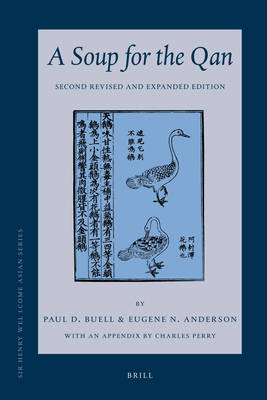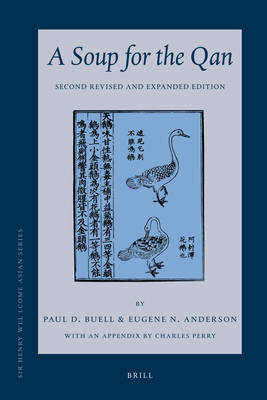
- Afhalen na 1 uur in een winkel met voorraad
- Gratis thuislevering in België vanaf € 30
- Ruim aanbod met 7 miljoen producten
- Afhalen na 1 uur in een winkel met voorraad
- Gratis thuislevering in België vanaf € 30
- Ruim aanbod met 7 miljoen producten
Zoeken
A Soup for the Qan: Chinese Dietary Medicine of the Mongol Era as Seen in Hu Sihui's Yinshan Zhengyao
Introduction, Translation, Commentary, and Chinese Text. Second Revised and Expanded Edition
Paul D Buell
€ 230,95
+ 461 punten
Omschrijving
In the early 14th century, a court nutritionist called Hu Sihui wrote his Yinshan Zhengyao, a dietary and nutritional manual for the Chinese Mongol Empire. Hu Sihui, a man apparently with a Turkic linguistic background, included recipes, descriptions of food items, and dietary medical lore including selections from ancient texts, and thus reveals to us the full extent of an amazing cross-cultural dietary; here recipes can be found from as far as Arabia, Iran, India and elsewhere, next to those of course from Mongolia and China. Although the medical theories are largely Chinese, they clearly show Near Eastern and Central Asian influence.
This long-awaited expanded and revised edition of the much-acclaimed A Soup for the Qan sheds (yet) new light on our knowledge of west Asian influence on China during the medieval period, and on the Mongol Empire in general.
This long-awaited expanded and revised edition of the much-acclaimed A Soup for the Qan sheds (yet) new light on our knowledge of west Asian influence on China during the medieval period, and on the Mongol Empire in general.
Specificaties
Betrokkenen
- Auteur(s):
- Uitgeverij:
Inhoud
- Aantal bladzijden:
- 680
- Taal:
- Engels
- Reeks:
- Reeksnummer:
- nr. 9
Eigenschappen
- Productcode (EAN):
- 9789004180208
- Verschijningsdatum:
- 23/08/2010
- Uitvoering:
- Hardcover
- Formaat:
- Genaaid
- Afmetingen:
- 173 mm x 244 mm
- Gewicht:
- 1224 g

Alleen bij Standaard Boekhandel
+ 461 punten op je klantenkaart van Standaard Boekhandel
Beoordelingen
We publiceren alleen reviews die voldoen aan de voorwaarden voor reviews. Bekijk onze voorwaarden voor reviews.








